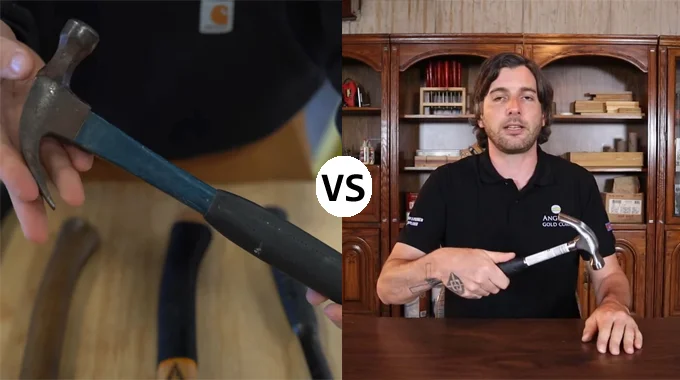Last Updated on January 30, 2023
With construction, having the right tool for any job is an absolute must. Take framing hammers and claw hammers as examples. Both of these workhorses ensure that whatever you’re building stands strong and sound.
While those hammers may appear quite similar at first glance, they have significant differences.
Framing hammers are used for mounting and ripping construction work, while the latter is best suited to drive out nails and hammer them into place.
Beyond purpose-specific features, the size and weight design of each tool vary. So handling the process has never been easier or more efficient.
Our goal here is to help you determine what hammer will work best for your project by examining its individual characteristics.
Comparisons of Framing Hammer Vs Claw Hammer
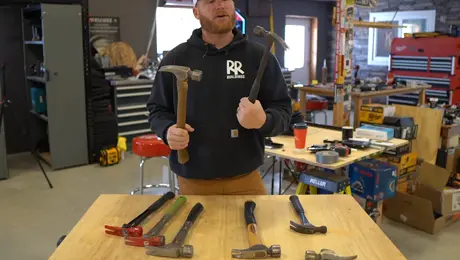
Comparing framing hammers and claw hammers can be challenging. Both tools have unique features that make them outstanding. Though here are some key distinctions to consider:
Size and Weight of the Hammers
The size and weight of framing hammers are generally larger than that of claw hammers. Framing hammers are typically 16-32 oz with long handles measuring 16-18 inches in length. The head of a framing hammer usually has two faces, one with a rip claw and another with an elongated striking face.
As opposed to this, a claw hammer is usually 10-20 oz with short handles measuring 10-13 inches in length. The hammer head also features a curved claw designed for prying out nails or materials. While the other face has a smooth striking surface.
Grip Style and Ergonomics of the Hammers
The grip style on framing and claw hammers differs depending on its intended use case. Even so, both types offer good ergonomic features that reduce user fatigue during extended periods of use.
Framing Hammers typically feature textured rubber grips along its handle that provides extra comfort during heavy-duty projects. When pounding in nails or metal fasteners into walls or other hard materials, this feature also provides better control.
Claw Hammer usually features leather grips on its handle that provide extra comfort while working on smaller tasks such as furniture construction or repair. This feature also allows users better control over delicate tasks where precision is required.
Use Cases for Each Type of Hammer
A framing hammer is mostly used in large building projects such as roofing jobs where heavier forces are required when pounding nails into hard surfaces such as concrete or bricks. Carpenters use hammers for many different jobs, such as trimming wood pieces before putting them into walls or ceilings.
The long handle on a framing hammer provides more leverage when the carpenter is trying to drive a nail into something, making it easier to hit the nail head.
On the other hand, claw hammers are mostly used in small building projects such as furniture assembly, where precision is more important than the force applied.
They can also be used in various repair jobs around the home due to their shorter handle length. This allows users more precise control over the nail removal process.
What are the Similarities Between Framing Hammer and Claw Hammer?
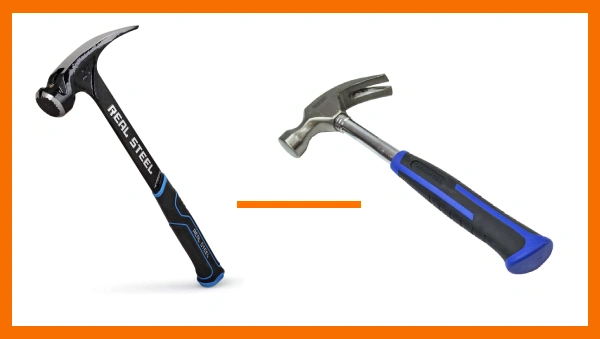
As you can see from above, there are many differences in framing and claw hammers. Still, despite their distinct features, these two tools have some commonalities as well.
Here are some similarities between them:
Usage
Framing hammers and claw hammers are designed to drive nails into wood, as well as help with dismantling nailed-together items. This is done by using the ‘faces’ of both types of the hammer to hit the heads of nails into the wood so they can be secured in place.
Similarly, the two types of hammers have slightly curved surfaces. The force is spread out evenly across the surface when you hit a nail or object. This helps to prevent the wood from splitting when you drive in the nail.
Head Design
The hammer’s head of both framing hammer and claw hammer have two distinct sides. The first side has a ‘face’ which is typically flat with a slightly convex design, allowing for a more even distribution of force when hitting objects such as nails or chisels.
The second side has a ‘claw’ which can be used to remove nails from wood if necessary. Both types of hammers also share a ‘neck’ design which is used to help distribute force throughout the entire hammer head when striking an item with it.
Handle Design
They both have handles that are designed to provide an ergonomic grip for long hours of use when working on projects or repairs around the house. Most modern designs have either wooden or metal handles.
They are strong enough to withstand heavier strikes and are still comfortable to use for extended periods of time. Some manufacturers also offer rubberized material on their handles for improved grip and comfort.
Pros & Cons of Using a Framing Hammer And Claw Hammer
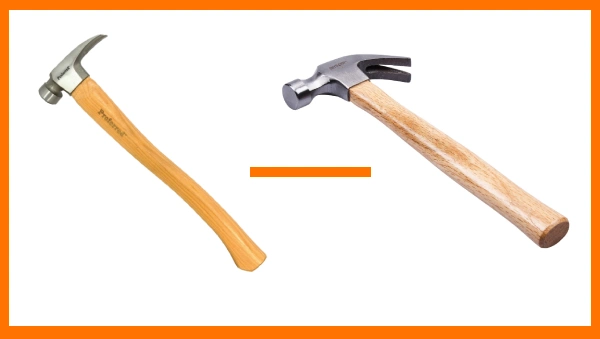
Claw hammers and framing hammers both provide unique benefits depending on your project. But be sure to consider all of their advantages and disadvantages before picking one.
Here are some of the Pros & Cons for each:
Pros of Framing Hammer
- Increased speed and efficiency in driving nails.
- Added versatility for demolition work and other projects.
- Comfortable handle for grip and easier weldability.
- Greater precision and control over strike points.
- Magnetic tip holds nails securely in place for more accurate placement.
- Heavier head weight allows for more powerful strikes.
- Ability to drive nails deeper without bending or breaking them.
Cons of Framing Hammer
- Too heavy for some people.
- Not as versatile as a claw hammer.
- Less durable than a claw hammer.
Pros of Using a Claw Hammer
- Widely available.
- Lightweight construction makes it easier to handle than a framing hammer.
- Curved claws allow for easier removal of nails.
- A short handle improves maneuverability when working in limited spaces.
- Easy to find replacement parts if the damage is sustained on the head or handle.
- Lower price point than other types of hammers.
- It can be used as a pry bar.
- A great option for homeowners who don’t do much DIY work.
Cons of Claw Hammer
- There’s sometimes an imprint of a waffle on wood.
- Not very effective for demolition jobs.
- The head may slip on a wet surface.
How Is a Hammer Considered a Framing Hammer?

A framing hammer is typically distinguished from a traditional claw hammer by its heavier head, which makes it better suited for driving nails into hardwood. As well as its longer handle that provides more power and leverage.
The head of the rip hammer also typically features a milled face and straight claw, which are designed to provide increased control when driving nails.
Aside from that, the handle may be shaped for comfort, such as with an ergonomically designed grip or rubberized texture. This design ensures that the user can maintain a secure grasp on the tool while using it, particularly in wet or slippery conditions.
Do Carpenters Usually Use a Framing Hammer Or a Claw Hammer?
Carpenters typically use both framing and claw hammers, depending on the nature of their project. A claw hammer is ideal for driving nails into softer woods or pulling them out of surfaces. Since it has an angled claw to pry nails and a flat striking face for hammering easily.
Framing hammers are good for bigger jobs like building walls and foundations on construction sites. They have a heavier head and longer handle so you can hit the nails harder.
This keeps your hands further away from the strike zone. They also feature milled faces that grip onto nailheads better during removal than traditional rip hammers.
Which Is Better For Pulling Nails: Framing Hammers Or Claw Hammers?
Framing hammers are generally better at pulling nails due to their unique design features, such as their heavy hammer heads, longer handles, and milled faces. That all contributes to greater gripping power when removing fasteners from surfaces. Claw hammers can still be used effectively in this manner.
Despite this, these rip hammers do not provide as much power as the larger hammers because they have shorter handles and lighter heads. This may cause you to get tired more quickly when trying to pull out nails that are stuck in hardwoods or other dense materials over time.
Can You Use a Claw Hammer for Framing?
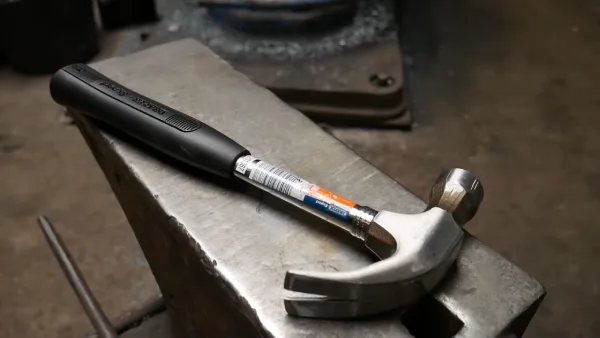
The use of a claw hammer is acceptable for framing. A claw hammer is designed with a flattened head compared to the standard curved head of a regular claw hammer. This allows it to be used for mounting and ripping wood as it provides more contact surface area when striking a nail.
When driving nails into wood, the framing hammer’s extra weight provides extra power and force. Some claw hammers have a checkered face. This helps to prevent the rip hammer from slipping off the nail when you are trying to hit the nail.
Having a checkered face makes it more accurate and efficient when you are framing.
Why Do Framing Hammers Have Checkered Faces?
Framing hammers feature checkered faces to ensure better grip when striking the large nails, allowing for greater precision when driving nails into the wood. The small ridges on the face of the hammer help create friction between the metal surface so that it does not slip off when struck.
This increases accuracy and reduces slippage, which helps prevent damage to the material being worked on. Also, having a checkered face on your framing hammer helps reduce friction over time by dissipating some of the shocks created when driving nails into hard surfaces.
Personalize Your Project: Choose the Right Hammer
Choosing the right hammer for your project can make all the difference. When deciding on a hammer, it really comes down to personal preference. Should you go with the classic claw or the trusty framing? Consider size and weight for ease of use along with the shape/design/grip style that best fits your intended project.
One way or another, taking stock will result in an ideal choice, no matter what kind of job needs doing. From a framing hammer to a claw hammer, understanding how they vary gives you an advantage in tackling any task with confidence.
Now that you know what type of hammer is best suited to suit your needs, go forth and take on whatever challenge comes next.
